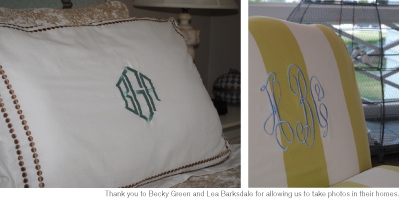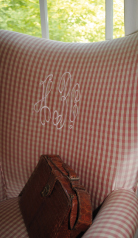Preppy, Peppy and Personalized: Using Monograms at Home
 I am a child of the 80s. That decade has shaped my musical taste, my love for sitcoms, and my decorating style. Alex P. Keaton from the TV show “Family Ties” would have been impressed with my prized possession in middle school: a kelly-green wool sweater embroidered with my initials in hot pink. I loved wearing it with my wooden handle purse with, you guessed it, a monogrammed cover. It was the height of the preppy movement, and monogramming was a popular way to personalize apparel. My love affair with placing initials on items had only just begun!
I am a child of the 80s. That decade has shaped my musical taste, my love for sitcoms, and my decorating style. Alex P. Keaton from the TV show “Family Ties” would have been impressed with my prized possession in middle school: a kelly-green wool sweater embroidered with my initials in hot pink. I loved wearing it with my wooden handle purse with, you guessed it, a monogrammed cover. It was the height of the preppy movement, and monogramming was a popular way to personalize apparel. My love affair with placing initials on items had only just begun!
Fast forward to today, and you see monograms everywhere—on beach towels, on children’s backpacks, on women’s jewelry, on cars, and on household items. Almost anything can be personalized, but it can be challenging to figure out what initials go where. A few rules will help you make choices that will brighten up the most ordinary objects, adding polish and sophistication to your home.
The Last Name Goes Where?
THE TRADITIONAL APPROACH: Single last name initial in a larger size, flanked by first and middle initials. This is often done in a script font for a more formal look.
Allison (first) Thompson (maiden or middle) Williams (last) looks like:
![]()
BLOCK PARTY: If you choose a block style (which is often considered more masculine, often used for male monograms), the initials should all be in the same size font in a clean typeface, and listed in the same order as the name.
John (first) William (middle) Pearson (last) would be printed as:
![]()
SINGLED-OUT: It is acceptable to use a single initial on any item. If you choose this option, use the first letter of the last name. When picking this monogram style, take care to look at the font and the thread color carefully, as you will want the initial to make a statement. You may choose to add embellishment to the design for an extra touch of interest.
Barnette could appear as:
![]()
WEDDED BLISS: Historically, a woman will change her monogram to reflect her new surname if she takes her husband’s last name. This monogram should be used on all linens and other household items (lampshades, trays, pillows). The husband’s monogram should be used on barware items (glasses and flasks). If a single initial is used for monogramming, and the bride has taken the groom’s surname, it should always be the first initial of this shared surname.
In more modern times, it is acceptable to use both the woman’s and the man’s name in the monogram. The acceptable format is to place the woman’s initial first, the last name in the middle noted by an oversized initial, and the man’s name on the right-hand side.
Margaret and Robert Hawthorne would appear as:
![]()
If the wife didn’t take her husband’s name, then an acceptable monogram style is to either use the first initial of both last names (use a block style), with the woman’s initial always placed on the left-hand side. If the couple has decided to hyphenate their last names, do not use the hyphen in the monogram. Another option is to use both full monograms separated by a symbol.
Lucy Robertson Smith and Henry Arthur Jones
could appear as:
![]()
in the single combined format or
LSR • HJA
in the combined monogram
SPECIAL CASES: If the last name is one such as O’Connell, McMahon or Van Noppen, only use the first letter of the last name (O, M, and V respectively). However, if it is a lower case letter (van Noppen), both can be used (VN).
If you go by a double first name (Mary Anna), and have four full names, there is a choice to be made: four letters in block style, or drop the second name.
Example: For Mary Anna Stewart Burns
![]()
are both acceptable
 Letters, Letters Everywhere!
Letters, Letters Everywhere!
When choosing what to monogram and which fonts and colors to use, consider your own personality as well as your home’s décor and style. Are you traditional or modern? Do you favor floral or geometric patterns? Do you like neutral or bright colors? Are you looking for a statement piece, or for something to subtly add elegance to a room? These answers will help you choose from the abundance of monogramming options. If you still find it hard to choose, take a more contemporary approach and mix two fonts and colors. With monogramming these days, anything goes—you just need to be happy with the look of the final product, and make certain that you see a final proof before any monogramming is done. Also keep in mind that certain letters look different than expected when placed on their own, or when printed in script versus block fonts (think capital I, J, G). Take this into account when making your font selection.
Give the Ultimate Personal Gift
Fall is a great time to think about monogramming items around your home. Spruce up your décor for upcoming holiday entertaining or give super-personalized gifts with monogrammed items. Start shopping and monogramming now, and you’ll be right on time for the holidays. Here are some items on which to place your mark:
FOR THE ELEGANT HOME: dining chair slipcovers, soaps, letter topiary made of ivy, armoires, headboards
FOR A CHILD: wall stencils, backpacks, lunch boxes, umbrellas, pencil pouches
FOR THE NEWBORN: Baby blankets, bibs, burp cloths, shirts, diaper covers, sippy cups, hats, bags, cribs
FOR YOU: tissue box covers, trash cans, cutting boards, lampshades, pillows, soap dispensers, planters
FOR YOUR SASSY FRIENDS: mousepads, trays, plates, cosmetic bags, travel coffee mugs, jewelry
FOR HIM: shirts, flasks, ice buckets, cuff links, wine stoppers
FOR A WEDDING GIFT: towels (hand, bath, kitchen), table linens (napkins, tablecloths, placemats), frames
FOR THE GRADUATE: laundry bags, stationery, mirrors, decorative letters to hang, robes
Using monograms in your home can be a great way to add personal touches that reflect your self and style. Be creative, add embellishment, and use whimsical patterns and fonts. Just be sure you don’t overuse this technique—a little bit goes a long way in adding this personal touch to your home.






